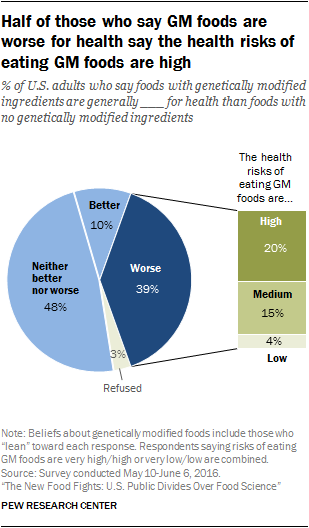Genetically Modified Crops and the Public Perception
Biotechnology’s evolution in the modern world is apparent in multiple industries, including agriculture. Genetically Modified Organisms (GMOs) are among the essential progress that biotechnology has made to solve food shortage and security issues. Purdue University (n.d.) describes GMOs as organisms-plants, animals, bacteria, and fungi whose genetic material’s alteration through genetic engineering procedures. The experiments, in return, yield entirely different organisms possessing characteristics that differ from the previous versions. It’s vital to get a comprehensive understanding of GMOs as, since their introduction, controversial dialogues have risen due to concerns that these products’ consumption, mainly crops and animals, are unhealthy.
Purpose of Genetically Engineering Crops
The need to solve food shortages during adverse conditions caught the attention of biotechnologists who developed genetically modified crops. Genetically modified crops were first commercially planted in the 1990s (FDA, 2020). Scientists further performed assessments of impacts in and away from the farms. The primary purpose of developing most of these crops was to have products with three essential characteristics; resistance to damage by insects, resistance to plant viruses, and herbicide tolerance (FDA, 2020). However, genetically modified crops have many additional advantages: higher nutrient content, such as the golden rice that tackles Vitamin A deficiency, which causes night blindness (Qaim, 2020). Genetically modified crops also increase output due to their ability to resist pest attacks, for example, Bacillus thuringiensis (Bt) crops (Qaim, 2020). Furthermore, higher yields prompt the need for additional labor during harvesting, therefore increasing income and subsequent profits for farmers mostly in developing countries, such as soybeans and corn grown in North and South America, respectively (Qaim, 2020). Genetically Modified crops’ ability to resist environmental and physical stresses makes them vital in the agricultural industry.
Process of Developing GMOs
Producing genetically modified organisms is a complex one involving several critical steps to achieve the desired product. First, identifying the genetic material of interest occurs and is then isolated from the donor organism (ABNE, 2017). This organism can be a fungus, bacteria, or another plant. The gene must contain the desired trait, for example, insect or drought tolerance and its specific position in the donor identified before its extraction.
Secondly, the gene’s insertion into a vector follows. By recombinant DNA technique, the gene’s insertion occurs into the plasmid of Agrobacterium tumefaciens that serves as a vector for the gene’s transfer into the recipient (ABNE, 2017). Some plant cells pick up pieces of the plasmid called T-DNA in a transformation process (ABNE, 2017). Thirdly, the selection and regeneration of modified plant cells into whole plants occurs using a selectable marker. The marker confers the desired traits and favors the growth of altered cells (ABNE, 2017). Only those who express the selectable marker gene survive upon exposure of the cells to specific antibiotics or herbicides.
Fourth, the genes undergo testing and analysis to verify if they interfere with the plant’s normal functioning. Researchers perform gene expression- production of mRNA and proteins of interest to ensure the target gene’s functional (ABNE, 2017). Once the verification is complete, the plant’s performance testing occurs using the transformed cells to regenerate whole plant cells through culture-based methods (ABNE, 2017). Lastly, the plant’s food and environmental safety procedures follow before the final product’s release into the market to be grown commercially.
Regulations to GMOs
Genetically Modified crops, despite the advantages, still receive opposition. Notably, in Europe, concerns relate to probable health and environmental risks. Therefore, GM crops receive much more scrutiny than conventional crops. Consequently, governments employ the safety regulations that assess these crops’ potential threats to provide conclusions on their viability (Qaim, 2020). The rules, however, might discourage small firms’ investment due to the expenses and encouraging concentration of agricultural biotechnology industry by larger firms, therefore, promoting monopoly
Genetically modified foods are currently ubiquitous products in grocery stores and supermarkets. According to Andrews (n.d.), about 80% and 92% of all corn and soybeans that the US respectively grows are modifications of original crops. However, there are differing opinions concerning the safety of these crops. Studies done on various animals indicated some health risks associated with Genetically Modified foods, including infertility, fast aging, and compromised immune system (Andrews n.d.). However, most claims are speculations, and only a few are scientifically proven. The pros outweigh the cons, therefore, concluding that Genetically Modified crops are fit for human consumption.
In conclusion, GM foods seem to have underrated benefits and overrated risks in the public’s eyes due to a lack of a vivid understanding. GMOs’ popularity is undeniable as lots of commercially available products in stores and supermarkets are genetically modified. GMOs’ production is challenging, and the government takes the relevant measures to ensure minimum risks to the environment and the public. Nonetheless, the benefits of these products to some degree outweigh the potential risks, which most are not scientifically proven; thus, GMOs shouldn’t inflict fear on the public as they’re safe for human consumption.







